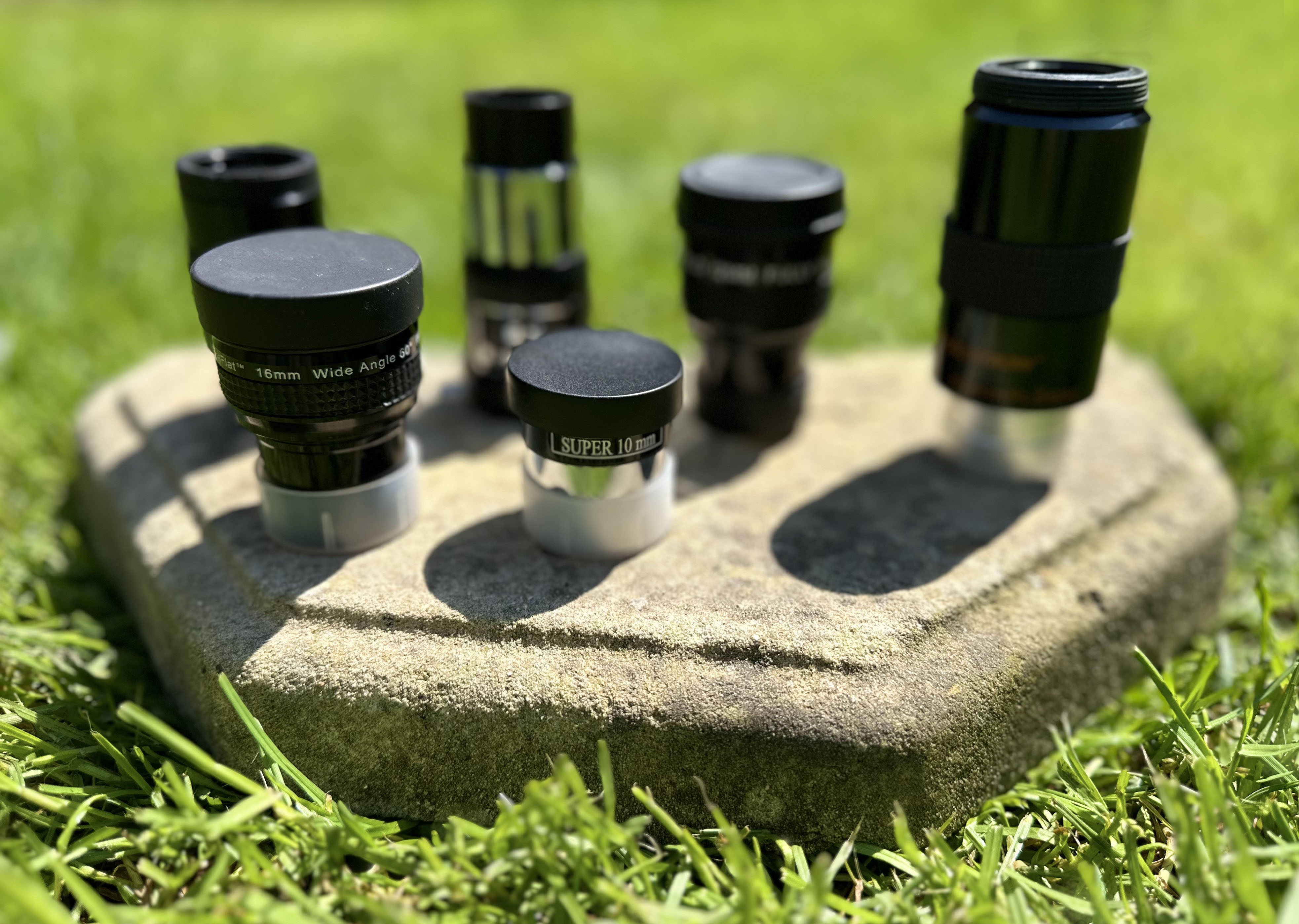
For those starting astronomy here are some relevant details and explanations.
The eyepiece purpose is to magnify the image created by the objective i.e. lens or mirror.
We shall use a 10" (250mm) mirror diameter Dobsonian telescope as an example; with a focal length of 60" (1500mm).
Power (or magnification)
This is determined by dividing the focal length of the telescope (mirror or lens type) by the focal length of a given eyepiece.
e.g. With a 25mm focal length eyepiece we get 1500/25 = 60.
Exit pupil or eye beam
The width of the light beam exiting the eyepiece and entering your eye.
- To find the 'eye beam' size for a given eyepiece divide the objective lens or mirror by the magnification of a particular eyepiece.
e.g.
For a 15 mm eyepiece giving 100 x magnification we get 250/100 = 2.5 mm. - To find the magnification to give you the largest field of view (FoV) divide the objective lens or mirror by a 6mm eye beam, this matches the fully dilated iris of your eye giving 6mm pupil; average for most people.
e.g.
For a 10" (250 mm) mirror then minimum magnification will be 250/6 = 40 times.
For a 16" (400 mm) mirror then the minimum magnification will be 400/6 = 66 times (the bigger the scope the smaller the field).
Note: A larger eye beam is inefficient as some of the eye beam (light) is 'lost' on the iris and doesn't enter the eyes pupil.
Eyepieces Apparent field of view (APoV)
These are the usual ones: 52, 60, 68, 70, 82 and 100 degrees (the larger the angle the more they cost).
True field of view
This is the 'apparent field' of the eyepiece divided by the magnification of a particular scope system.
For example: with the 10" Dobsonian, with a 25mm eyepiece giving 40 times magnification and with a 68 degree eyepiece the apparent field will be:
68/40 = 1.7 degrees. This is over 3 times the diameter of the Moon.
With a 100 degree eyepiece:
100/40 = 2.5 degrees. (this is almost 5 times the diameter of the Moon).
So, you can see that you get more sky at the same magnification with an expensive large field eyepiece.
Eye Relief
This is the distance from the eyepiece, that the eye has to be, to get the maximum field seen, usually between 10 and 20mm. If you wear glasses then you need 'Long eye relief (LER) eyepieces so that your glasses can fit in between the eyepiece and your eye.
Maximum Magnification
The highest magnification that you can go to usually depends upon the 'seeing' of the atmosphere. In the UK the maximum is usually below 250 times (usually written: x 250)
e.g.
With the 10" (250) Dobsonian with a focal length of 60" (1500mm).
To get the focal length of the eyepiece to give x 250 we get 1500/250 = 6 mm. This also gives an exit pupil (eye beam) of 250/250 = 1.0 mm.
For most Dobsonian telescopes in the 8" to 12" ranges I would recommend the following (60 to 70 degree field) focal length eyepieces
| Power | mm | Average |
|---|---|---|
| Low | 25 - 30 | 28 |
| Medium | 14 - 16 | 15 |
| High | 7 - 10 | 9 |
With the 10"(250) Dobsonian with a 60" (1500) focal length we get the following table using 68 degree (APoV) eyepieces
| Eyepiece focal length (mm) | Mag (x) | True field | Eye beam (mm) |
|---|---|---|---|
| 28 | 54 | 1.2" or 72' | 4.5 |
| 15 | 100 | 0.68" or 41' | 2.5 |
| 9 | 167 | 0.40" or 24' | 1.5 |
| [37 | 41 | 1.7" or 102' | 6 (largest true field)] |
For higher magnification with the above eyepiece a 'Barlow lens' can be used. This can effectively multiply the focal length of the scope by 2, 3 or 5 times depending on what you choose.
If using a x 2 Barlow (most usual) with the above lenses we get the following magnification
28 becomes effectively 14 and gives x 110
15 becomes effectively 7.5 and gives x 204
9 becomes effectively 4.5 and gives x 340
Note: An exit pupil or eye beam of 1.5 - 2.0mm will give the best definition if looking at the planets or moon.
Any questions, please feel free to ask, we are always happy to help.
Rod